Today I drove a couple of kilometers, five or six, I think, to the place called Palera, and took a walk by the sea.
I searched for insects, and I found some. That means you'll see plenty of macro photographs in this post. The scenery always looks good or great in that area, so I took a few wide shots as well.

I parked near one of the abandoned buildings of a former military base that appeared a few days ago in one of my recent posts and then walked across the meadows to the sea.
On the unpaved road, not far from my parked car, I saw this beautiful bird, the Upupa epops, commonly known as the Eurasian hoopoe.
By the side of the road, on the dry remains of the Scolymus hispanicus plant, I found a well-camouflaged shield bug.

The insect is barely recognizable in this and the previous shot. The bug is nicely hidden in the hollow that once hosted a flower and then the seeds.
With a little incentive from my forefinger, the shield bug was convinced to leave that perfect hideout and pose on the dry, thorny leaves where it was visible enough for a fairly good portrait. The name of the species is Carpocoris purpureipennis. This isn't an adult. In all these shots you can see a 4th instar nymph.
A couple of meters from there, on the Verbena officinalis plant ...

... I found a group of much younger Carpocoris purpureipennis nymphs.
These tiny 1st instar ones have hatched very recently. They are still congregated around the cluster of empty eggs.

I find these baby shield bugs kind of cute.

While photographing the Verbena officinalis flowers ...

... I noticed something move in the center of one of them.
Here, especially if you enlarge the picture by clicking on it, you'll be able to take a relatively good look at the minuscule creature. This is a trip. A tiny insect from the order Thysanoptera. Can't tell you what species exactly is this.
After some more walking, fifty or sixty meters further ...

... I came across another dry Scolymus hispanicus plant ...

... and I found another group of immature Carpocoris purpureipennis bugs.

Most of them were 4th instar nymphs, the type of nymph you saw earlier in the post...
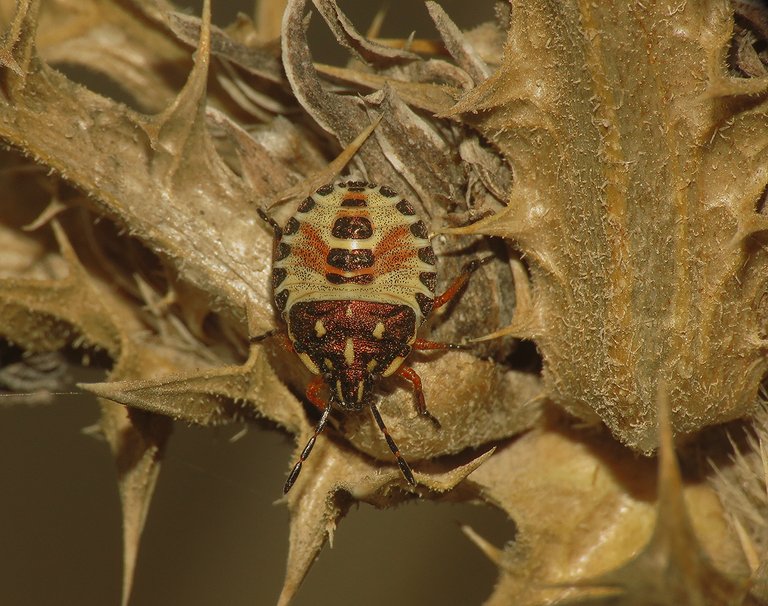
... but I also photographed one smaller 3rd instar among them. In the following photograph ...

... I came closer to that one.
About ten or fifteen minutes later, and a bit closer to the sea ...
... I saw the hoopoe again.
The bird was searching for food among the low vegetation five or six meters from the shore.
The Eurasian hoopoe eats a wide variety of things from insects, small frogs & lizards to seeds and berries.
Here you can see a fishing boat that was returning to the harbor of the nearby village of Liznjan. This type of boat hunts the sardines in the deeper water outside the bay.
I continued rambling through the grass and other herbaceous vegetation and at one point ...
... a few grasshoppers jumped before my feet so I crouched, mounted the macro lens again, and started sneaking around in the hope of photographing at least one of them.

It took me five or six minutes to get this portrait ...

... of a well-camouflaged Chorthippus biguttulus grasshopper. I felt lucky enough, but then ...
... I successfully approached another grasshopper.

In an environment made of an intricate mix of brown and green plant parts, the colors and markings of both grasshoppers provide a perfect camouflage.
The name of this second species is Aiolopus strepens.
Here you can see a little yellow detail hidden among the taller vegetation of the uniformly brown-green meadow - the flowers of the Lotus tenuis plant.
Half an hour later, on the same meadow ...

... I photographed another well-camouflaged grasshopper.
This is the small nymph ...

... of the pretty big migratory locust (Locusta migratoria).
On the way back to the car, I stopped by this natural floral arrangement made of two plants, the Eryngium amethystinum that provided the thorny greenish-violet parts, and the Picris hieracioides that added the lovely yellow flowers to the stylish mix. On one of those yellow flowers ...
... I photographed this bug from the Rhopalidae family.
It looks like some species from the genus Maccevethus of that family, but I'm not sure.
In this photograph, a tiny fy is posing next to the bug on the vivid yellow petals of the flower.
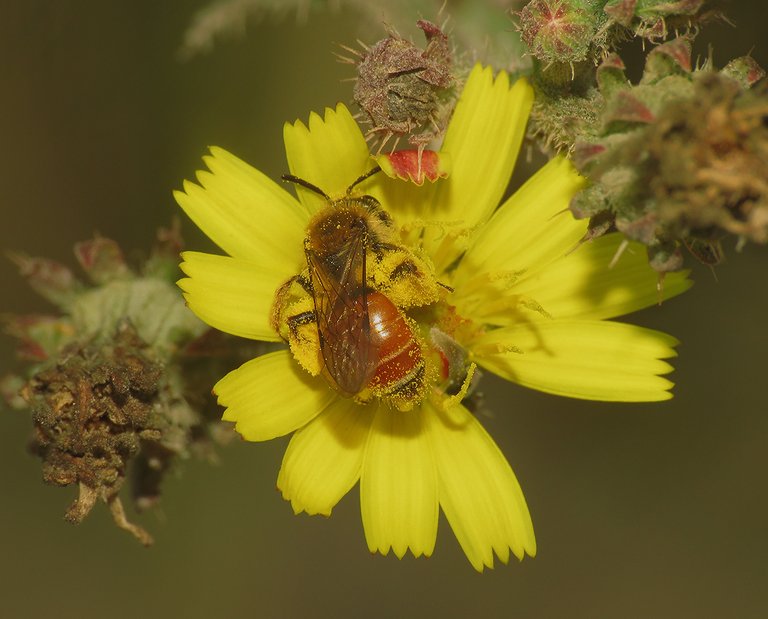
On another flower, very close to my car, I found this bee I wasn't able to identify. I think that it belongs to the Andrenidae family. But there is a good chance that I'm wrong. After photographing the bee ...

... it was time to go home.



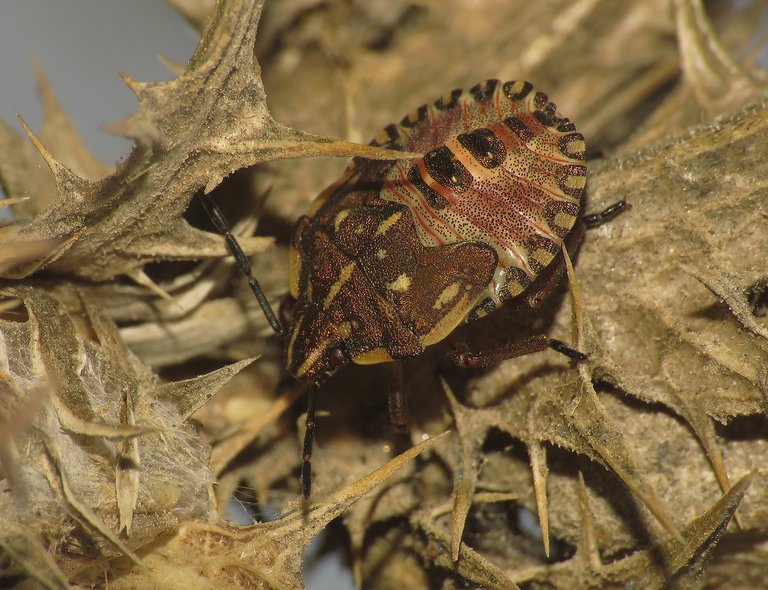












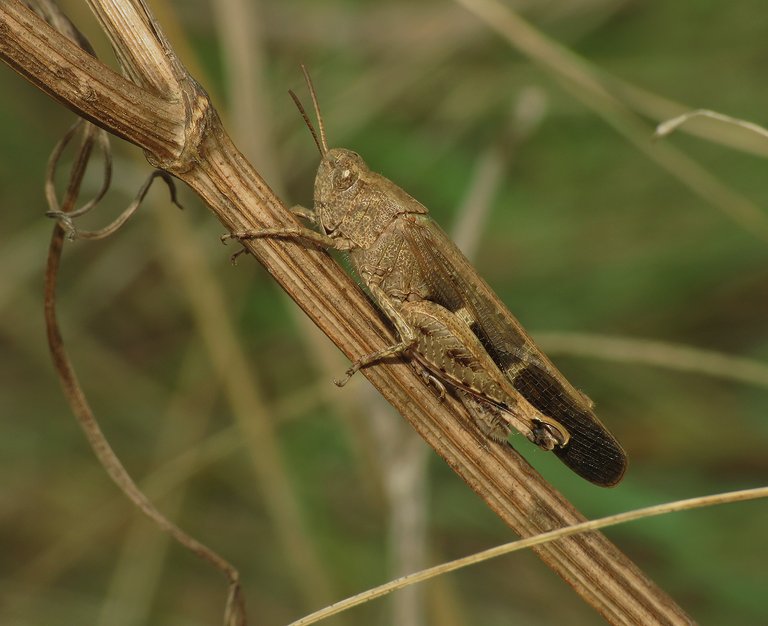

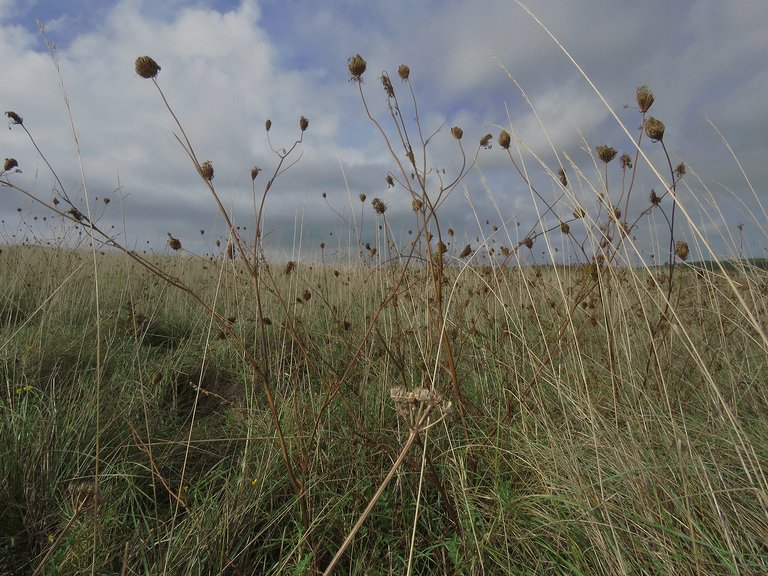





Congratulations @borjan! You have completed the following achievement on the Hive blockchain And have been rewarded with New badge(s)
Your next target is to reach 21000 replies.
You can view your badges on your board and compare yourself to others in the Ranking
If you no longer want to receive notifications, reply to this comment with the word
STOPCheck out our last posts:
Mother Nature is so very clever, by creating that bizarre looking "Scolymus hispanicus" plant, to provide the perfect cover for the shield bug. Most impressive indeed!
Nature always fascinates me, have an awesome "Nature hunting" day! !VSC !LOLZ 😎
Thank you. 🙂
@fun.farms has sent VSC to @borjan
This post was rewarded with 0.1 VSC to support your work.
Join our photography communityVisual Shots
Check here to view or trade VSC Tokens
Be part of our Curation Trail
@fun.farms ha enviado VSC a @borjan
Éste post fue recompensado con 0.1 VSC para apoyar tu trabajo.
Únete a nuestra comunidad de fotografía Visual Shots
Consulte aquí para ver o intercambiar VSC Tokens
Se parte de nuestro Trail de Curación
lolztoken.com
She really hit the roof!
Credit: reddit
@borjan, I sent you an $LOLZ on behalf of fun.farms
(3/10)
How it could be possible if @borjan is looking for insects and doesn't find them? you are perfect at it.
the weather looks fine and all the insect pictures you have captured are detailed and perfectly captured. I really liked the Rhopalidae insect sitting on the yellow flower.
Want to Know more about Hivepakistan? Ping Us On our Discord by clicking on the given link: https://discord.gg/3FzxCqFYyG
In Case You want to Show Love to HivePakistan, click on any of these links ;)
🙂
The Eurasian hoopoe is stunning. I live in South Africa and have seen somethng very similar. Do you know if they have some kind of family this side of the world? I thought of it as a 'woody woodpecker'. Not sure if it's the same thing, or whether I'm way off lmao. Great pics my friend!
Yes. 😀 Google says that African hoopoe, which is a subspecies of the Eurasian one and looks practically the same, can be seen in South Africa.
That's so dope.. then I reckon I've seen that here in the Western Cape. Brilliant! Cheers my friend.
Just as I expected from you, the pictures are amazing and the walk too.
Thank you 🙂
You're welcome.
These are wonderful, but how do you know all their botanical names though? After taking pictures of them you search for their botanical names?
Yes. When I come back home and transfer the photographs to the computer, I search for the names through Google Pictures and some sites specialized in botanical stuff.
It is difficult to find a hoopoe in our area, but it is possible that it is a very cautious bird that does not like to be approached very close, excellent photographs!
!ALIVE
@borjan! You Are Alive so I just staked 0.1 $ALIVE to your account on behalf of @ peter-stone. (1/10)
The tip has been paid for by the We Are Alive Tribe through the earnings on @alive.chat, feel free to swing by our daily chat any time you want, plus you can win Hive Power (2x 50 HP) and Alive Power (2x 500 AP) delegations (4 weeks), and Ecency Points (4x 50 EP), in our chat every day.

Very inspiring and insightful. I enjoyed it alot
That Hoopoe is so cute, it's looking like a zebra with the stripes.lol
The Eurasian Hoopoe looks so unique! I admire how you could capture and write a blog like this just walking around.
That's somehow inspiring to always pay attention to our sorroundings..
Again a great photos. End picture is so beautiful that I have seen this again and again. Lovely weather and lovely flowers. Full of freshness. Every where you can see the beauty of nature.
Increíble es muy raro ese insecto escudo cada día conozco más de ellos hay muchas especies.
Langosta migratoria bebé 😍 está muy hermosa esa foto.
Wow! Excellent pictures well detailed. This is thorough and on point. Well done!
Mother Nature is always fascinating, more in photography. Super nice!
Wow that is a great place
Casi es indetectable el saltamontes en la rama naturaleza perfecta..
The views in the coastal area are very beautiful, especially the big ships.
Amazing and nice pictures, hope you had fun out there
Awww! That Eurasian hoopoe looks beautiful and the pink flower looks amazing too. You got nice photographs as always
#hive #posh
The bird looks very beautiful and very unique
These are really amazing pictures I must confess 🤩
You always showcase lovely photos, and the stories on them.
The capture of the pictures is quite good that my friend showed.
The bird is very unique, with a very high crest.
El ave abubilla luce imponente en el ecosistema marino..
Barco ⛵ casa sardinas cerca del puerto es única esa foto muy bonito contenido de verdad felicidades..y gracias por compartir.
Those are wonderful flower. You have found some amazing cricket, grasshopper and bug. Those are looking so beautiful. Nice photography
Wow! You found a lot of beautiful things in that walk and I love the most is the Eurasian hoopoe. I like the striped wings.
Wow, I enjoyed your journey and your pictures were very clear. The hoopoe bird looks kind of scary. you went to feed your eyes with a lot of nice creatures. I used to enjoy hanging out around the sea.
The captures are so beautiful. You seemed really professional with photography.
Because if you click on one of those images in ecency, the photograph will appear in a new window and will be much larger.